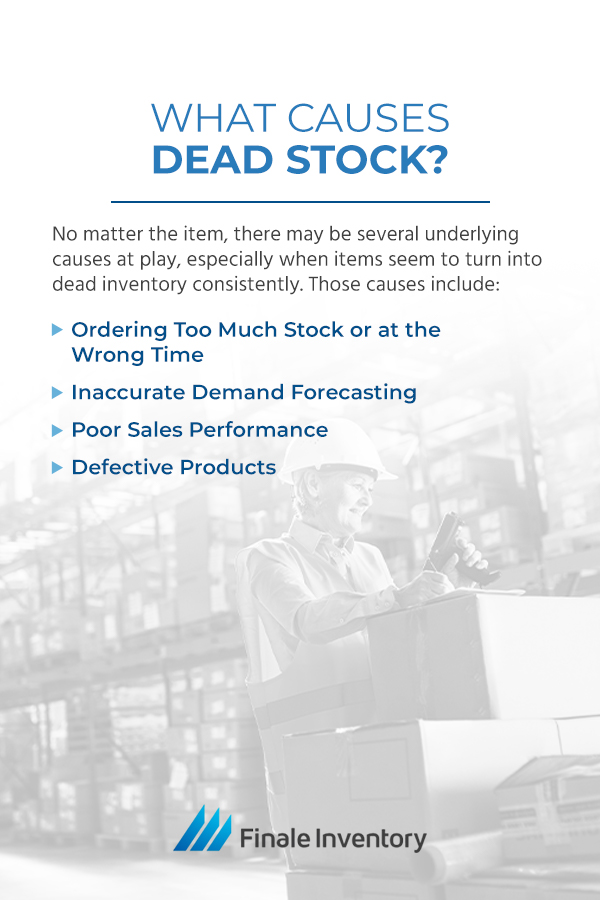On average, 20%-30% of a company’s inventory is dead stock — which is a sizeable concern. At its most basic, dead stock is inventory that’s impossible or very unlikely to sell. It’s a step above overstocked goods, which is at risk of becoming dead inventory unless it is sold or otherwise repurposed. Unsellable inventory is a huge liability, and keeping it in check through proper inventory management is critical. Understanding the meaning of dead stock, identifying it in your warehouse and learning to prevent it can set you up for success.
What Is Dead Stock?
Dead stock is the inventory in your warehouse or storeroom that’s no longer sellable and will likely never sell. It may be expired, obsolete, out of season or low quality. You may be able to identify dead stock by its expiration date or if it is out of season. However, you may have certain items that simply aren’t selling at all for unknown reasons. Dead stock only refers to unsold items. While merchandise that has been returned may be broken or otherwise unsellable, it is not considered dead inventory.
Dead stock, or dead inventory, is something that slowly accumulates over time. With perishable goods, items may move closer to dead stock the closer they get to their expiration date. For example, while day-old bread is less likely to sell than fresh bread, it may still find paying customers at a bakery outlet store. However, once the bread passes its “sell-by” date, it becomes dead inventory.
Other times, items become dead stock as a season draws to a close. For example, on January 2, 2021, all New Year’s decorations that read “2021” became obsolete. However, generic holiday decorations may find customers shopping for clearance decor for next year.
In general, items slowly descend to the status of dead stock. It starts when an item’s sales velocity reaches its peak and starts to decline. As sales dwindle, such as toward the end of a fashion season, items are categorized as “slow-moving inventory.” Then, items that remain unsold become “excess” or “overstocked” inventory and then eventually turn into dead stock.
The timeline for how long it takes an SKU to become dead inventory can vary depending on the type of item. For accounting purposes, products that haven’t sold in one fiscal year become dead stock and are considered a liability.
Dead Stock vs. Deadstock
In defining the term “dead stock,” it’s important to discuss the differences between dead stock — two words — and deadstock — one word. While dead stock is an inventory concern that needs correction, deadstock may be desirable.
Consumers use “deadstock” to refer to coveted items that are no longer available. Deadstock can include vintage items or certain discontinued items with a niche appeal. In the sneaker enthusiast community, sneakers in “deadstock condition” are unworn sneakers available at a discount. In these two meanings, deadstock items are highly desirable and likely to sell in specific markets.
What Causes Dead Stock?

Dead stock is more common among specific product categories. For example, fashion items come in and out of season in as little as a few months. Perishables like food and medicine may become dead inventory in just a few weeks or less. Seasonal items like holiday decor may have just a month or two before the leftover inventory turns into dead stock. No matter the item, there may be several underlying causes at play, especially when items seem to turn into dead inventory consistently. Those causes include:
1. Ordering Too Much Stock or at the Wrong Time
Ordering stock requires consideration for how much you can sell within a given time frame. Estimating replenishment orders without looking at sales data and inventory turnover rate typically leads inventory managers to order excess stock. Ordering too much inventory at once may mean you’ll have more merchandise than you can unload before the items expire or go out of season.
Another common mistake is ordering inventory too far after its popularity peaks. For items with limited sales windows, like fashion and holiday items, it’s critical to monitor your sales velocity against your estimates for when the regular season ends. Ordering the same quantity of holiday lights on December 15 as you did on November 15 will likely yield some excess inventory.
Use some key data points when considering your reordering schedule to avoid ordering too much or too late, such as:
- Inventory turnover ratio: Understanding how quickly you can sell a given quantity of inventory is critical to prevent overstocking. Your inventory turnover rate is how many times you can completely turn your inventory in a year. If the ratio is low, it may mean you’re ordering too much at once.
- Reorder point formula: Using a dynamic reorder point formula helps you determine how much to reorder and when given your current market conditions. In Finale Inventory, you can calculate your reorder points automatically using your sales velocity, desired safety stock, supplier lead times and desired days of inventory. This calculation helps you reorder inventory only when you need it.
2. Inaccurate Demand Forecasting
A 2020 industry study found that inaccurate demand forecasting is the primary cause of dead and slow-moving inventory. It’s critical to look at your sales history for the last few months and for this time last year to help you estimate your reorder quantities and deadlines. In Finale Inventory, you can access this historical data alongside current sales trends to help you forecast demand and make sound decisions.
3. Poor Sales Performance
Another potential hiccup relates to marketing. If your customers do not want to buy the product you have for sale, it will slowly turn into dead stock. It’s essential to provide adequate marketing for your products to increase shoppers’ awareness and encourage them to buy. It’s also crucial to analyze the product itself. Is the price point something your target market is willing to pay? Is this product a good match for your target customers? When you’re having trouble selling a product, consider strategies such as:
- Product kitting: Bundling similar items together for a special deal helps you sell slower-moving inventory faster. A common approach is to pair a slower-selling item with a fast-selling product. While you’ll sell the items for a lower cost than you would selling them individually, it helps you save on holding costs and unload inventory before it becomes dead stock.
- Discounts: Another option is to lower the price point or place the item on clearance. You’ll attract customers hunting for deals and those who felt that the full price was too high. Running promotions and discounts is one of the fastest ways to prevent excess stock from turning into dead stock.
- Adding sales channels: Another potential marketing issue is that your customers don’t know a product is available or don’t see it on their preferred shopping platform. You might add the item to marketplaces such as Amazon, eBay or Walmart alongside your e-commerce website or physical store. Then, more customers will see your items and consider buying them.
4. Defective Products
Items may arrive at your warehouse unsellable because they are defective. If you get them from suppliers, you may return them and avoid holding any dead stock. However, you must negotiate how you’ll deal with defective goods before placing orders with suppliers. Some discussion points include:
- Product specifications: If you contract out a specific product to a third-party manufacturer, it’s crucial to discuss the product specifications. By specifying physical requirements such as dimensions and raw materials, you can send back items that do not meet the requirements. It’s vital to examine items as soon as they arrive at your warehouse so you can quickly identify defective products and prevent your business from accidentally selling them to a customer.
- Packaging requirements: You can also specify the packaging materials and quality level to ensure items arrive safely at your warehouse and to your customers. Packaging that doesn’t meet your standards can be sent back, especially if items arrive broken.
- Accepted quality limit (AQL): When you enter into a contract with a supplier, you can specify an AQL for the maximum number of defective items you’ll accept. If your quality control inspections reveal that a batch has too many faulty units, you can send them back and request a new batch.
How Does It Hurt Businesses and Warehouses?
Unsellable merchandise is a significant liability for e-commerce businesses, warehouses and retail stores alike. Some of the reasons why dead stock is so bad include:
- Unsold inventory: When you have dead stock, you likely purchased it while it was still sellable and valuable. Unless you can unload these items for a profit or at least to break even, you’ll forfeit the initial acquisition costs, including freight, duties and insurance.
- Storage and holding costs: Whether you rent or own your warehouse space, hanging onto inventory you can’t sell raises your storage costs. According to the Association for Supply Chain Management, holding costs can represent up to 55% of your inventory costs, and within those costs, obsolescence accounts for roughly 6%-12% of your total inventory expenses.
- Lost opportunity: Besides raising your storage costs, housing unsellable items takes up space that could go to more profitable live inventory. Thus, dead stock cuts into the profit potential of your fast-moving stock. Also, when you manage to sell dead stock, it’s usually at a loss. Thus, you may lose the opportunity to profit off of your investments.
- Increased staffing: When you have more items in stock, you often need more staff to manage the items. When some of that inventory is unsellable, you’re paying more in wages than what will ultimately contribute to your profitability.
- Cost of money and restricted cash flow: When you hang onto inventory for a long period before selling it, you can lose profits even if you break even on the sale. Unloading merchandise soon after you acquire it avoids eating into your margins through inflation. However, stock that’s been in your possession for a year or more will be worth less even if the market price hasn’t changed. Also, businesses often rely on liquidating inventory assets to fund future inventory purchases. Hanging onto unsold inventory for an extended period restricts your cash flow. Cash tied up in dead merchandise can cost a business 15% or more of the original inventory investments.
How Can You Avoid It?
Even the most well-managed warehouses will sometimes end up with dead stock. However, the following stock control techniques paired with powerful technology and reliable data can help in avoiding dead stock:
1. Inventory Reduction
The best possible way to avoid excess stock that ages out of usefulness is to reduce your buffer stock levels and purchase smaller quantities more frequently. You’ll reduce your holding costs dramatically for both your fast-moving and slow-moving products. When you do end up with dead stock, it’s usually a smaller quantity and a smaller loss.
To employ this strategy effectively, you need highly accurate inventory records and an effective system for tracking stock levels in real time. Finale Inventory does this by monitoring your sales and purchasing records to update your stock availability in real time.
Our software can also provide low stock alerts and even trigger reorder notifications. When you set up dynamic reorder forecasting, Finale Inventory will alert you of the exact quantity and date to reorder, accounting for supplier lead times and desired days of inventory. We’ll generate a purchase order with information from your supplier catalogs so all you have to do is look things over and send it out. Your replenished inventory will arrive exactly when you need it to stay in-stock, given your current sales velocity.
2. Tracking Sales History and Current Sales
It’s just as critical to consider how much stock you can reasonably sell in a given period. Consider your long-term sales history, and pay attention to yearly trends on the rises and falls in demand. When you’re coming up on a predicted peak, order more stock. When you see that sales are likely to decrease, cut back on your stock.
Next, combine this information with your current sales velocity. Are items performing better or worse than this time last year? This data will help you determine exactly how much to reorder and when. Also, watching when your sales start to dip lets you react with a price change or increased marketing to compensate for the reduced demand.
If you use Finale Inventory, your current sales velocity is automatically factored into your reorder point calculations.
3. Weighing the Benefits and Risks of Holding Inventory
The eternal dilemma of dead stock is that holding onto inventory, even the slowest-moving stock, ensures you have items available for sale. Preventing dead stock isn’t always necessary. Keeping some extra merchandise, even at the risk of overstocking, is sometimes worth it. Safety stock helps you prepare for an unexpected influx of sales. For non-seasonal items, keeping a little buffer inventory may help you take advantage of sales opportunities when demand increases.
It may also be worth hanging onto seasonal items that may still come back in season the following year. While the leftover seasonal stock may increase storage costs, if you can sell it the following year at or near full price, it may be worth hanging onto. If you do so, consider moving it to an area of the warehouse dedicated to leftover seasonal stock. This gets it out of the way, freeing up space closer to your loading dock for faster-moving items.
Inventory Reduction Strategies
Reducing your inventory on-hand without sacrificing sales opportunities is a crucial strategy to prevent accumulating dead stock over time. Besides ordering smaller quantities more often, other inventory reduction tactics include:
- Review safety stock levels: While you’ll likely keep at least a small amount of safety stock on hand to account for supplier delays and upticks in demand, you should regularly conduct an inventory analysis and review how much you’re holding. If you rarely get close to your safety stock levels, it may be worth lowering them.
- Reduce supply chain lead times: If you can reduce your lead times, you can effectively reduce your stock levels with less concern that you won’t be able to restock before your current supply runs out. On your end, you can simplify the approvals process for reordering stock and hire more staff to shorten your processing time when replenished inventory arrives. You can also look for suppliers who are closer to your location and others who can guarantee a shorter lead time.
- Consider using just-in-time (JIT) inventory management: If you can reduce your lead times, you might consider using JIT inventory management. Under this technique, you only place orders with your supplier when a customer orders the item from you. You might even have these items drop-shipped so they never arrive in your warehouse.
- Micromanage your most valuable stock: It may not be feasible to use JIT for every item, especially for high-demand, fast-moving products. Choose your highest-value inventory to keep on hand and use the JIT approach for all your mid-speed and slow-moving stock.
Learn More About Finale Inventory
Finale Inventory is a feature-rich, flexible inventory management software that can help your company get a handle on its inventory. When you use Finale Inventory, you can safely reduce your inventory levels without sacrificing sales opportunities, thanks to real-time data and sophisticated reorder point alerts. We offer capabilities to help you track inventory across multiple warehouses and sales channels, alongside tools for e-commerce inventory management and raw materials inventory tracking for light manufacturing.
To learn more about Finale Inventory, start your free trial or schedule a live demo today.






